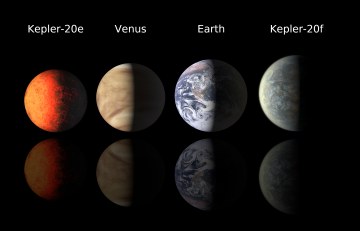 This week NASA’s Kepler telescope found two Earth-sized exoplanets orbiting Kepler-20, which lies about 946 lightyears from Earth. Truly marvellous, wondrous, as Coxy might say.
This week NASA’s Kepler telescope found two Earth-sized exoplanets orbiting Kepler-20, which lies about 946 lightyears from Earth. Truly marvellous, wondrous, as Coxy might say.
But, I am fairly sure that a lot of the people getting excited by these Earth-like planets are doing so because they somehow imagine we might one day colonize them rather than simply being in awe of the universe.
One day, you say? Travelling at the speed of light, it would take 946 years to reach the star system. That’s the speed of light, right? 299,792,458 metres per second. 946 light years is about 9 billion billion metres. The fastest spacecraft we have built so far, the Helios solar probe, has a top speed of 252,792 kmh, that’s a smidgeon over 70000 metres per second. So, a little over 4 million years to reach Kepler at that speed, if I’ve done my arithmetic correctly.
Either way, it’s a long time even at the speed of light. And, unfortunately, despite Einstein allowing wormholes, there was recent depressing news that “warp speed” will forever remain a fictional construct and superluminal neutrinos really don’t exist. Those colonisation plans will have to be put on hold unless Prof Brian Cox and his colleagues can somehow accelerate a nanoscopic black hole at the LHC…oh never mind…